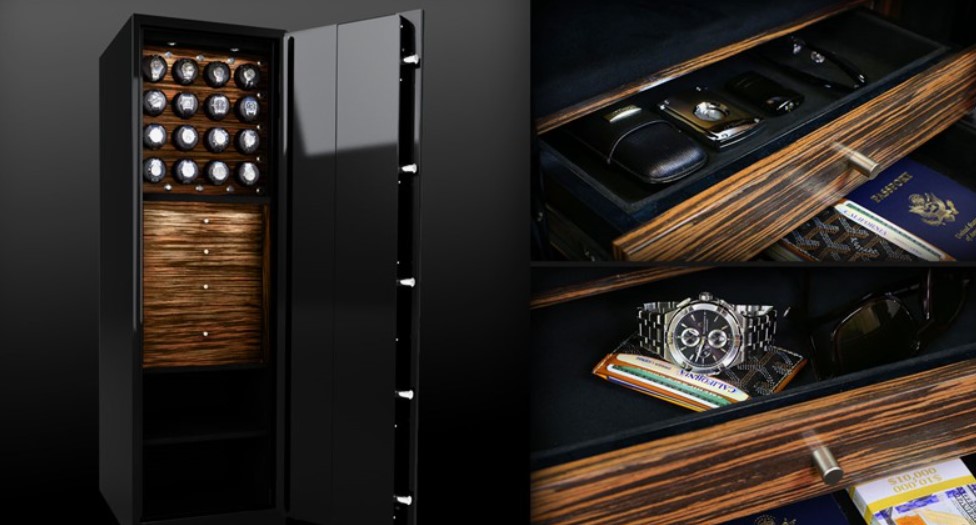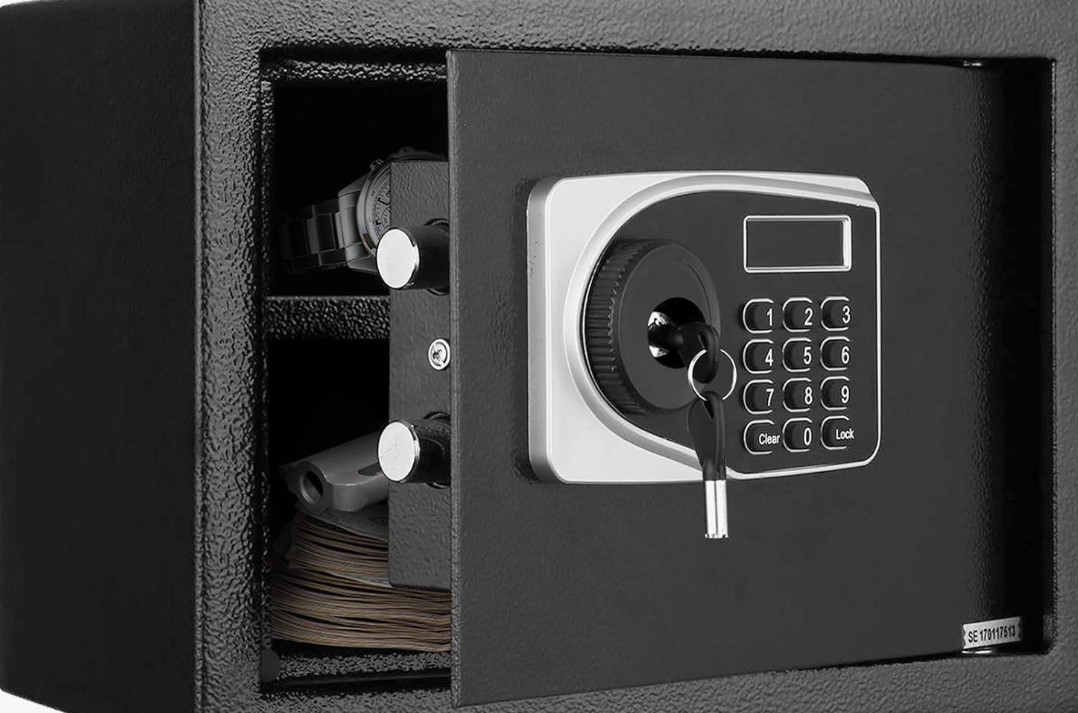As the value and complexity of luxury watch collections grow, so does the need for specialized security solutions. While regular safes offer a basic level of protection for valuables, watch safes are specifically designed to address the unique needs of timepieces. This article explores the key differences between watch safes and regular safes, emphasizing why these distinctions are significant, especially for collectors in Dubai and the UAE.
Page Content
Understanding Regular Safes: General Security for Valuables
Regular safes are designed to store a wide range of valuable items, including cash, documents, jewelry, and electronics. They provide basic security features such as locking mechanisms, fire resistance, and sometimes water protection. However, their design is generally focused on versatility rather than specialization. Regular safes come in various sizes and models, catering to the general need for safeguarding assets from theft and environmental damage. In the context of Dubai, where luxury is prevalent, regular safes might fall short in offering the specific protections required for high-value watch collections, which demand tailored features.
What Sets Watch Safes Apart?
Watch safes are engineered with the specific needs of watch collectors in mind. Unlike regular safes, watch safes often include features such as automatic watch winders, climate control, and customized storage compartments to prevent damage to delicate watch mechanisms. These safes are built to maintain the precision and longevity of timepieces, addressing concerns like humidity, temperature fluctuations, and mechanical wear. For collectors in Dubai and the UAE, where the climate can be harsh, these features are not just luxuries—they are essential to preserving the value and functionality of luxury watches.

Security Features: Tailored vs. Generic Protection
The security mechanisms in watch safes are typically more advanced than those in regular safes. Watch safes often incorporate biometric access, multi-point locking systems, and integration with smart home security networks, providing a higher level of personalized security. These features ensure that only authorized individuals can access the safe, adding an additional layer of protection. In contrast, regular safes may rely on more generic security options such as combination locks or keypad entry, which, while secure, do not offer the same level of customization and specificity required for high-value collections.
Climate Control: Essential for Watch Preservation
One of the most significant differences between watch safes and regular safes is the inclusion of climate control features. Watches, especially those with leather straps or intricate mechanical movements, are sensitive to environmental conditions. Watch safes often include humidity control, temperature regulation, and even air filtration systems to create an optimal storage environment. This is particularly crucial in Dubai, where high humidity and temperatures can negatively impact watch materials and mechanisms. Regular safes, lacking these features, can expose watches to conditions that may accelerate wear and degrade their value over time.
Watch Winders: A Unique Feature of Watch Safes
Watch winders are a defining feature of watch safes, designed to keep automatic watches wound and ready for wear. This functionality is important for maintaining the accuracy and longevity of timepieces that rely on motion for operation. Watch winders can be set to specific rotation patterns and speeds, ensuring that watches are kept in optimal condition. Regular safes do not offer this level of care, as they are not designed with the intricacies of watch maintenance in mind. For collectors in Dubai, where luxury watch collections are often both investments and personal treasures, the inclusion of watch winders in a safe is a significant advantage.
Interior Design: Customization vs. Standard Layouts
The interior of a watch safe is typically customized to accommodate different sizes and styles of watches, with soft lining and individual compartments to prevent scratches and damage. Some watch safes also offer modular designs, allowing collectors to adjust the layout as their collection grows. Regular safes, on the other hand, have more generic interiors, which may not provide the same level of protection or organization for delicate timepieces. For those in the UAE who take pride in displaying their collections, the aesthetic and functional customization of a watch safe is an important consideration.
Fire and Water Resistance: Levels of Protection
Both watch safes and regular safes offer fire and water resistance, but the standards and ratings can vary significantly. Watch safes are often designed to exceed basic safety standards, offering enhanced protection against extreme conditions. This is particularly relevant in environments like Dubai, where high temperatures could pose a risk even within a secured building. The fire resistance of watch safes often extends to the internal mechanisms, protecting not just the physical structure but also the sensitive components of the watches themselves. Regular safes, while providing a degree of fire and water protection, may not be equipped to safeguard the unique vulnerabilities of luxury watches.

Cost Considerations: Investment vs. Expense
The cost of watch safes is typically higher than that of regular safes due to their specialized features and enhanced security. However, for serious collectors, this cost should be viewed as an investment rather than an expense. A watch safe not only provides superior protection but also helps maintain the condition and value of a collection over time. In Dubai, where the market for luxury watches is robust and growing, the investment in a quality watch safe can be justified by the potential appreciation in the value of the collection. Brands like Argus Security offer watch safes that combine high-end security features with elegant design, catering to the specific needs of collectors in the region.
The Importance of Professional Installation
Professional installation is crucial for both watch safes and regular safes, but the complexities of watch safes often make this even more critical. Proper installation ensures that the safe is securely anchored and fully operational, with all features functioning as intended. For collectors in Dubai, where homes often feature advanced technology and luxury finishes, integrating a watch safe into the environment without compromising aesthetics requires expertise. Regular safes may be simpler to install, but the lack of specialized features means that the security benefits are not as pronounced.
Legal and Insurance Implications
Investing in a watch safe can have positive implications for insurance coverage, as many insurers recognize the enhanced security and offer reduced premiums for collections stored in certified watch safes. Regular safes may also contribute to insurance savings, but the benefits are typically less significant. It is important to consult with your insurer to understand the specific requirements and certifications needed to qualify for discounts. In the UAE, adhering to local safety regulations and working with insurers familiar with the nuances of luxury collections can maximize these benefits, providing additional peace of mind for collectors.
Conclusion
The collector’s specific requirements ultimately dictate the decision between a watch safe and a standard safe. The watch safe is the superior choice for individuals with high-value watch collections due to its specialized features, including climate control, watch winders, and advanced security. While conventional safes are adaptable, they do not provide the same level of customized protection for timepieces. Investing in a watch safe is not solely about security in Dubai and the UAE, where luxury watch ownership is prevalent and the climate presents distinctive challenges. It is also about the preservation of the value and integrity of a cherished collection. Collectors can make informed decisions that best safeguard their investments by comprehending the key differences and the reasons they are important.

Skateboarder, feminist, DJ, hand letterer and HTML & CSS lover. Doing at the sweet spot between beauty and function to create great work for living breathing human beings. I’m fueled by craft beer, hip-hop and tortilla chips.